Top>Opinion>Encouraging Nature Experiences
 Index
Index

Norimitsu Kageyama [Profile]
Encouraging Nature Experiences
Norimitsu Kageyama
Professor, Faculty of Law, Chuo University
Areas of specializations: Physical education, Outdoor pursuits, Outdoor education
What are nature experiences?
Nature experiences is a general term for activities performed in nature, and covers a range of things including mountain climbing, hiking, nature observations, open air tea ceremonies, and viewing the sunrise. Previous generations experienced nature a great deal, of course, but such opportunities have been decreasing compared to our grandparents' time. What about the experiences of modern day children? In eastern Japan, there will be a marked decline in nature experiences among children as a result of radioactive pollution. A society in which more and more people have never touched an insect, caught a fish, or climbed a tree seeks the unnatural environment of artificial urban areas rather than a natural environment. Although the media is reflecting an increased mood of interest in the natural environment, it is an imaginary, virtual natural environment and not really connected to any direct experience with nature. Feeling nature through all five senses enriches people's lives. Combining nature observation with a walk around your neighborhood is one easy pursuit that lets you experience nature. So go on, observe the nature around your home! Of course you must be careful to avoid traffic accidents, hornets, and so on, but you will always find something of interest even in a town such as the seasonal changes in city parks, roadside trees, and garden shrubs, and may even suddenly come across a wild animal such as a raccoon dog or Japanese rat snake. I myself have seen a kestrel, which is a kind of small falcon, at the North Exit of Chofu Station on the Keio Line as well as a bird of prey thought to be a goshawk flying leisurely above a junction at Akasaka-mitsuke in downtown Tokyo. A better knowledge of the ordinary nature around you may make you more able to sense big changes in the natural environment such as global warming and abnormal weather. Next I will introduce the nature observations I have conducted with my students.
Nature observations at Chuo University
Nature observations are carried out in hiking lessons within Chuo University in spring and autumn. The woods in the university grounds are mainly carbon woods such as konara oak, sawtooth oak and hornbeam. In spring, we can see the new shoots of the designated endangered species Cephalanthera falcata, Asarum tamaense, and calanthe, as well as Disporum smilacinum, Chloranthus serratus, Cephalanthera erecta, Scutellaria brachyspica, gold-banded lilies, spicebush, known for its use in making toothpicks for Japanese confectionary, Symplocos sawafutagi, Syneilesis palmate, a wild vegetable, and Hostas, famous in the Tohoku region as urui, another kind of wild vegetable. It has been 18 years since I began nature observations within the university grounds, and I feel that the spring blossoms are coming about one week earlier than before. In fall, the red leaves of the Japanese maples are beautiful, while around them I can also see many small maple seedlings. In the bare branches of the trees, I have seen the nests of ravens and turtledoves, and even the small nests of great tits made from spider webs.

Sawtooth oak
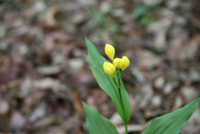
Cephalanthera falcata
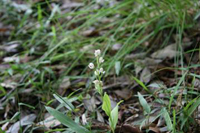
Cephalanthera erecta
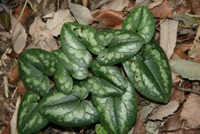
Asarum tamaense
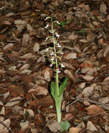
Calanthe
Bird-watching on the Tama River
Along the nearby Tamagawa River, we conduct bird-watching hikes from Seiseki-sakuragaoka Station to Tama City Traffic Park every spring and fall. Just downstream from Tama City Traffic Park, the Tamagawa River meets the Okurigawa River running to the south of Chuo University. At Sekidobashi Bridge in Seiseki-sakuragaoka, kestrels are sighted, and there have been frequent sightings in recent years of gray herons, great egrets, intermediate egrets, little egrets, kites, and a flock of great cormorants. Even a falcon was spotted once, which had come to eat a little egret that had been killed the previous day. Goshawks, famous for inhabiting in village forest are often seen above Tama City Traffic Park. When sighted, they are perched perfectly still on a branch surrounded by ravens. In the past, goshawks have apparently caught and eaten crested kingfishers on the Okurigawa River. Two kinds of swallow have been spotted, ordinary swallows and Asian house martins. Although no swallow can be seen since they have flown away to the south in fall, flocks of them roost along the sides of the Tamagawa River in summer. Kingfishers nest on the Okurigawa River and my students and I often see them diving into the water and catching small fish. In late fall, large numbers of ducks arrive from Siberia.
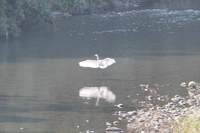
Great egret
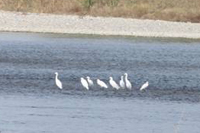
Little egret

Gray heron
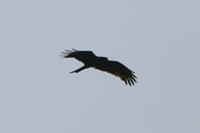
Kite
Nature skiing (observing nature on skis)
We go nature skiing in the Togakushi Highlands. Within a silvery world of snow more than two meters deep, we put on our Telemark skis and observe nature across Koshimizugahara and the forest park. In winter, there are signs of animal life that cannot be seen as close up in any other season, such as the footprints of foxes moving in a perfectly straight line, those of raccoon dogs winding slightly from side to side, pairs of marten footprints placed beautifully side by side, and the footprints of Japanese monkeys, young and old, printed in the furrows that their chests make in the snow. We can also reach the center of an ice-covered Kagamiike lake that can only be accessed in winter, or a huge Mongolian oak thought to be about 700 years old located in the middle of dense brush that can only be crossed when covered in snow.
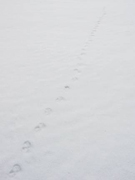
Fox footprints
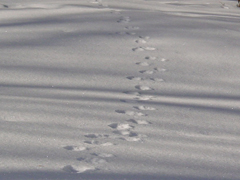
Raccoon dog footprints
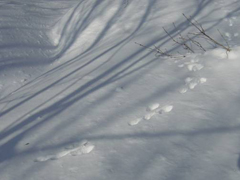
Hare footprints
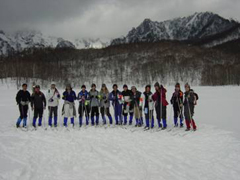
Nature skiing
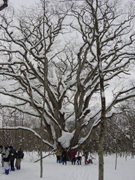
Approximately 700-year-old Mongolian oak
Field creation
Lessons are conducted with the concept of basic "sensory observation" of nature utilizing all five senses of hearing, sight, smell, taste and touch to try to generate an interest in the familiar natural world. This means I want my students to listen to, look at, smell, taste and touch various natural objects. Ultimately, I am happy if they can create their own field and set their own course. In creating such a field, I want them to consider and adopt historical, geographical, biological, and other perspectives. In addition to these perspectives, they can also provide a lot of variation by including the seasons of spring, summer, fall and winter. In this way, I hope they can sense from various perspectives the land's abundance of nature and its people and the mutual relationship between the two.
Activity target
As a target of students' daily activities during nature observation, I recommend that they measure their heart rate for one minute. The maximum activity intensity can be estimated by this equation: 220 - age = maximum heart rate. So for an activity intensity of 50%, the favorable heart rate will be 50% of the maximum heart rate. Suppose your age is 40, then your maximum heart rate is 180 beats per minute and so your desired heart rate for 50% activity intensity is 90 beats per minute. At first, try walking slowly for 10 to 20 minutes while experiencing an intensity of 50 to 60%. Gradually increasing the activity intensity to 60 or 70% for a period of 60 minutes is adequate for training. Take into account your physical condition, not forgetting to do warm-up and cooling down exercises, and pay full attention to other factors such as the weather. Research shows that doing this at least twice a week for 12 weeks produces positive results such as weight loss and improved circulatory function. If you observe nature while exercising, you will also better understand the beautiful transition of Japan's seasons all around you. Help to maintain and improve your health while enjoying nature.
- Norimitsu Kageyama
Professor, Faculty of Law, Chuo University
Areas of specializations: Physical education, Outdoor pursuits, Outdoor education -
Professor Kageyama was born in Ibaraki in 1954. In 1981, he obtained a master's degree from Graduate School of Comprehensive Human Sciences, University of Tsukuba in Physical Education Methodology (Outdoor Education) on the Master's Program in Physical Education. Between 1998 and 2000, he carried out overseas research on the Outdoor Pursuits Program at University of Oregon, Oregon, USA. He took up his current position in 2003.
Research papers:"A Study on the Change of Self-esteem and Loneliness in College Students who participated in Camp Courses", Japan Outdoor Education Journal, Japan Outdoor Education Society, 2001 5[1] pp. 49-59; "The Distribution of Strains on Telemark ski in turning -Comparison of Telemark turn and Alpine turn-", Journal of Ski Science, Japan Society of Ski Sciences, 2007 4[1] pp. 1-13.
- Research Activities as a Member of Research Fellowship for Young Scientists (DC1), Japan Society for the Promotion of Science (JSPS) Shuma Tsurumi
- Important Factors for Innovation in Payment Services Nobuhiko Sugiura
- Beyond the Concepts of Fellow Citizens and Foreigners— To Achieve SDGs Goal 10 “Reduce Inequality Within and Among Countries” Rika Lee
- Diary of Struggles in Cambodia Fumie Fukuoka
- How Can We Measure Learning Ability?
—Analysis of a Competency Self-Assessment Questionnaire— Yu Saito / Yoko Neha - The Making of the Movie Kirakira Megane








